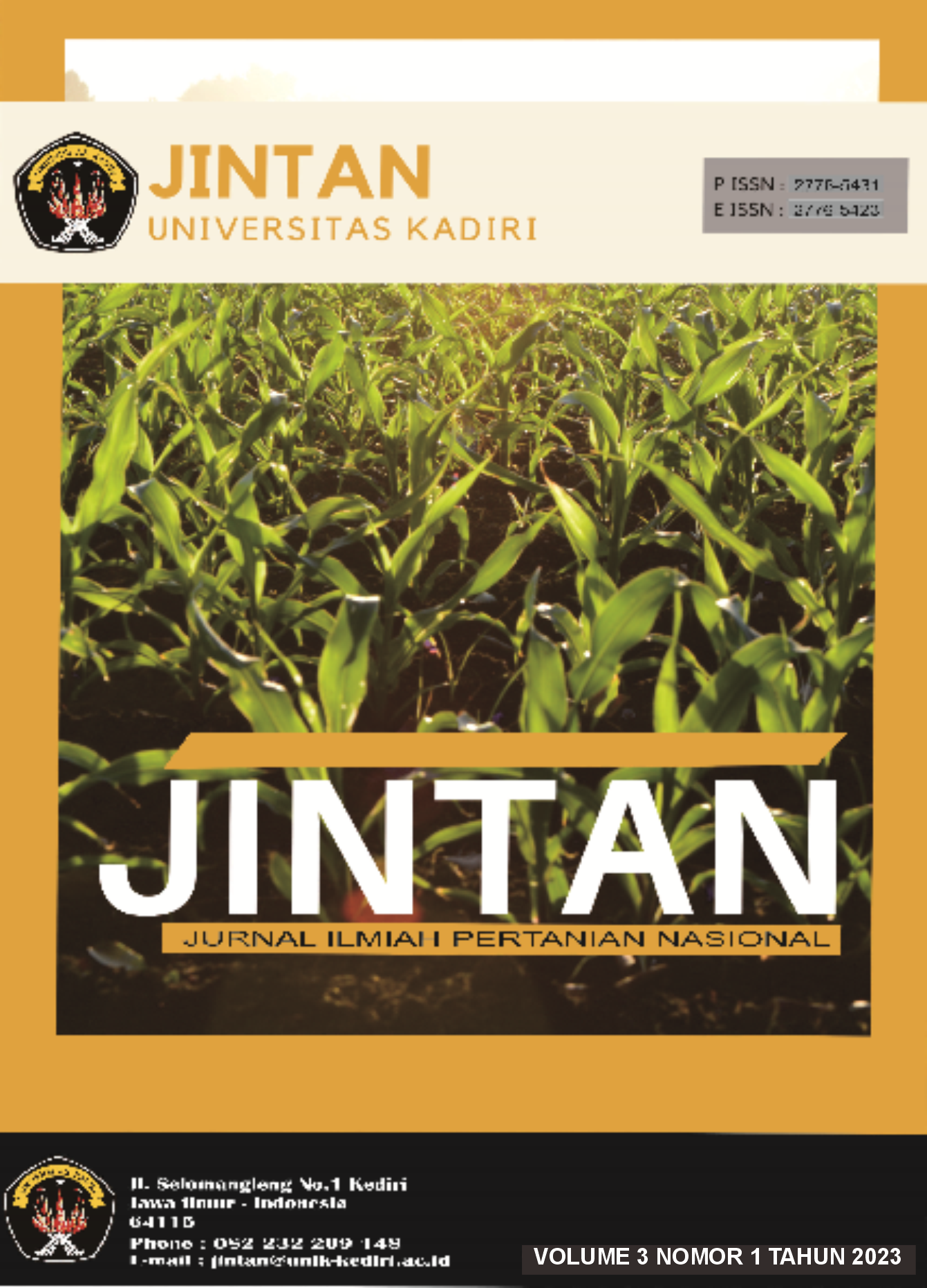Analisis Pendapatan Petani Bawang Merah Dengan Sistem Mulsa dan Non Mulsa di Kabupaten Nganjuk Tahun 2021 (Studi Kasus di Desa Sukorejo Kecamatan Rejoso Kabupaten Nganjuk)
DOI:
https://doi.org/10.30737/jintan.v3i1.4008Kata Kunci:
, Income, Mulch, Non-mulch.Abstrak
Shallot is the primary commodity for most farmers in Sukorejo Village Nganjuk Regency. The shallot planting system must be optimized to produce optimal products. This study aimed to determine the income of shallot farmers using mulch and non-mulch systems. The determination of the sample was stratified random sampling. Two categories of shallot farmers were identified as mulch system users and non-users. Analysis results showed that both categories simultaneously affected income. The mulch users gained an income of IDR 204,929,703, while non-mulch users earned IDR 267,901,111. Therefore, the income of farmers using a non-mulch system was greater than that of farmers using a mulch system. In conclusion, the absence of a mulch system helps farmers save more on production costs. The mulching system users require to pay more attention and extra care on the utilization to reduce maintenance costs.
Â
Bawang Merah merupakan komoditi utama bagi mayoritas petani pada daerah penelitian. Sistem penanaman bawang merah harus bisa dioptimalkan agar menghasilkan produk yang optimal juga. Penelitian ini memiliki tujuan untuk mengetahui pendapatan petani bawang merah sistem mulsa dan non mulsa. Pengambilan sampel menggunakan stratified random sampling Sistem Mulsa dan non mulsa secara bersama–sama (simultan) berpengaruh terhadap pendapatan. Perbedaan pendapatan dalam penggunaan Sistem Mulsa dan Sistem Non Mulsa di Desa Sukorejo Kecamatan petani yang menggunakan sistem mulsa memperoleh pendapatan sejumlah 204.929.703 dan sistem non mulsa memperoleh pendapatan sejumlah 267.901.111. Jadi pendapatan petani menggunakan sistem non mulsa lebih besar pendapatannya dibandingkan dengan petani menggunakan sistem mulsa. Sebaiknya petani menggunakan sistem tersebut karena lebih bisa menghemat biaya produksi. Untuk petani yang menggunakan sistem mulsa dibutuhkan perawatan yang lebih ekstra sehingga bisa lebih menekan pengeluaran biaya rawat.
Referensi
Anwarudin, O., dan Satria, A. (2020). Proses Dan Pendekatan Regenerasi Petani Melalui Multistrategi Di Indonesia Process And Approach To Farmer Regeneration Through Multi-Strategy In Indonesia. Jurnal Litbang Pertanian. https://Doi.Org/10.21082/Jp3.V39n2.2020.P73-85
Bayu Aji, S., Sutiknjo, T. D., dan Dinawati, E. (2020). Peranan Penyuluh Pertanian Terhadap Keberhasilan Penerepan Sistem Tanam Padi Jajar Legowo Di Desa Pagung Kecamatan Semen Kabupaten Kediri. Jurnal Agrinika : Jurnal Agroteknologi dan Agribisnis. https://Doi.Org/10.30737/Agrinika.V4i2.1075
BPS. (2018). Distribusi Perdagangan Komoditas Bawang Merah Indonesia Tahun 2018. In Badan Pusat Statistik.
BPS. (2021). Statistik Indonesia: Statistical Yearbook Of Indonesia 2022. Statistik Indonesia 2020.
Hasan, F., Darwanto, D. H., Masyhuri, dan Adiyoga, W. (2018). Risiko Produksi Dan Perilaku Petani Menghadapi Risiko Usahatani Bawang Merah Di Kabupaten Nganjuk. Inisiasi, 7(2).
Hidayat, S. I., dan Rofiqoh, L. L. (2020). Analisis Alih Fungsi Lahan Pertanian Di Kabupaten Kediri. Jurnal Social Economic Of Agriculture. https://Doi.Org/10.26418/J.Sea.V9i1.40646
Jenderal, S., dan Pertanian, K. (2014). Outlook Pusat Data dan Sistem Informasi Pertanian. Pusat Data Dan Sistem Informasi Pertanian.
Pertanian, K., Penelitian, J., dan Pengembangan Pertanian, D. (2015). Badan Penelitian Dan Pengembangan Pertanian. J.Litbang Pert.
Raharjo, S., dan Sudadi, U. (2015). Analisis Kesesuaian Lahan Untuk Komoditas Sayuran Unggulan Di Kabupaten Batang. Journal Of Natural Resources And Environmental Management. https://Doi.Org/10.29244/Jpsl.5.1.33
Sugiyono. (2008). Metode Penelitian Pendidikan: (Pendekatan Kuantitatif, Kualitatif Dan R & D).Alfabeta.
Sutas, T. (2018). Hasil Survei Pertanian Antar Sensus 2018. In Badan
Pusat Statistik.
Taufiq, M., Rahmanta, R., dan Ayu, S. F. (2021). Permintaan Dan Penawaran Bawang Merah Di Provinsi Sumatra Utara. Jurnal Agrica, 14(1). https://Doi.Org/10.31289/Agrica.V14i1.4759
Wibowo, R. (2016). Skenario Goal Programming Dalam Perencanaan Pola Tanam Petani: Kasus Daerah Balung Kabupaten Jember. Jurnal Agro Ekonomi. https://Doi.Org/10.21082/Jae.V2n1.1982.32-55
Unduhan
Diterbitkan
Cara Mengutip
Terbitan
Bagian
Lisensi
Authors who publish in this journal agree to the following terms:
- Authors retain copyright and grant the journal right of first publication with the work simultaneously licensed under a Creative Commons Attribution License (https://creativecommons.org/licenses/by-nc-nd/4.0/) that allows others to share the work with an acknowledgment of the work's authorship and initial publication in this journal. Permitted third party reuse is defined by the Creative Commons Attribution-NonCommercial-NoDerivs (CC BY-NC-ND). This permission allows users to copy and distribute the Article, provided this is not done for commercial purposes and further does not permit distribution of the Article if it is changed or edited in any way, and provided the user gives appropriate credit (with a link to the formal publication through the relevant DOI), provides a link to the license, and that the licensor is not represented as endorsing the use made of the work.
- Authors are able to enter into separate, additional contractual arrangements for the non-exclusive distribution of the journal's published version of the work (e.g., post it to an institutional repository or publish it in a book), with an acknowledgment of its initial publication in this journal.
- Authors are permitted and encouraged to post their work online (e.g., in institutional repositories or on their website) prior to and during the submission process, as it can lead to productive exchanges, as well as earlier and greater citation of published work.
- For open-access publishing, authors have the right to share their articles in the same ways permitted to third parties under the relevant user license, as well as certain scholarly usage rights.




